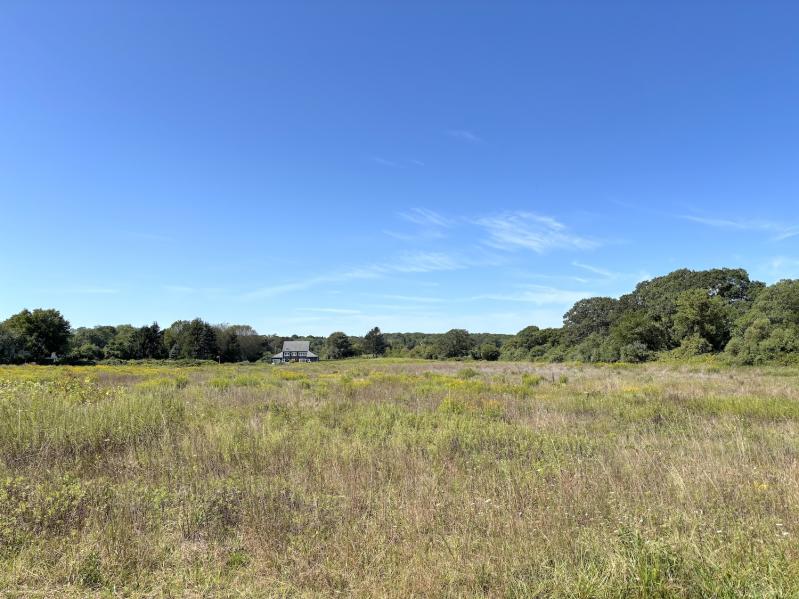Two East End crises converged at a Southampton Town Board public hearing last week: dwindling farmland and the loss of open space.
Nearly a dozen residents urged the board on Sept. 9 to switch the designation of an 8.3-acre preserved farmland parcel across from Wolffer Estate Vineyard in Sagaponack to open space. Sagaponack Mayor Bill Tillotson and David McMillan Jr., a Sagaponack Village Board member, opposed the change.
The field, purchased in 2021 from Geri Bauer, a farming advocate, using money from the community preservation fund, hasn’t been worked since at least 2018, partly because the town, along with the Peconic Land Trust, had been trying to figure out how a 1.7-acre scenic easement would affect potential operations. In the meantime, it had reverted to largely native grassland, raising its ecological value.
There seems to be an acknowledgement among local farmers that the soil is subpar and that fencing and irrigating the plot could be problematic and costly. Then there’s the location, bordering a sensitive pond, part of the Long Pond Greenbelt, land that was protected only after millions of private, town, and county dollars were expended to preserve it.
Hence the hearing. Despite the full room, in an ironic twist, Councilman Bill Pell started the discussion by calling for it to end. He wanted the hearing withdrawn.
“I feel that if the C.P.F. bought it as farmland, it should stay as farmland,” he said.
However, his colleagues on the board, Michael Iasilli, Rick Martel, and Cyndi McNamara, argued the hearing should continue.
“I think we can work on this and come up with something that not everybody is going to be happy with, but it’s something that will preserve our promise to the farmers of the area,” said Ms. McNamara. She stressed she didn’t support the property being fenced.
Mr. Pell floated a compromise: turn it into a flower field with buckwheat for bees. That sounded nice, but the crowd wasn’t buying it.
Neither was Mary Woltz, owner of Bees’ Needs, who, in a phone call after the hearing, said Councilman Pell was missing the point. “There are already wildflowers blooming there now — goldenrod and asters will follow,” she said. “It’s a polyculture now, feeding more than just my honeybees. Meanwhile, native pollinators live in the soil. If you plow that, you destroy the habitat. Why try to create something falsely that’s already there?”
Farmers raised concerns about precedent.
“My concern is what changing the designation on this land might mean for other farmland in the C.P.F. program,” wrote Marilee Foster, a Sagaponack farmer, in a letter to Councilwoman McNamara.
This became “the big unanswered question” raised by others also at the hearing.
While C.P.F. designations have been changed in the past, Daniel McCormick, counsel to the Community Preservation Department, told the board, “I’ve only been here three years, to my knowledge I don’t recall a designation change regarding farmland.” He said however, that parkland designations had been changed to open space and vice versa.
He was loath to say more in public, repeatedly telling the board he’d tell them more in executive session.
Whether stronger covenants could prevent future reclassifications remained unclear.
Jacqueline Fenlon, the town’s C.P.F. Director, didn’t return two calls to her office by the time The Star went to press.
“The conflict surrounding this small, marginal parcel in Sagaponack undermines the trust and assurance a farm family needs when they are trying to find ways to keep their farms viable and whole,” wrote Ms. Foster. She suggested a middle ground, different from Mr. Pell’s compromise. “Farmers often leave parts of their own property, that which is not the best, ‘open,’ ” she wrote. Perhaps that was the solution for the field, or at least a significant portion of it, cut through by a swale.
Environmental advocates pressed for full protection.
“We’re asking to change this one property back to what it should have been originally, a part of the Long Pond Greenbelt,” Dai Dayton, president of the Friends of the Greenbelt, told the board. “This property is important to protect an incredible coastal plains pond system that is unique not just here, but nationwide. You’re not going to find that on different farmland.”
She argued that switching the designation wouldn’t set a precedent. “It’s an individual decision.”
Mr. Pell softened. “If the C.P.F. can say, ‘Just leave it alone. We’re not going to farm it, but we’re not going to change it.’ I’m fine with that,” he said. “But if we can’t, and it has to be farmed, we have to find the best way we can farm it for the environment.”
James Burke, the town attorney, said nothing compelled the land to be farmed. “There is no affirmative obligation to farm a piece that we preserve under the farmland preservation program,” he said. “We hope that people will do it, but it’s not specifically required.”
Mayor Tillotson, who clearly wants the field farmed, referenced a comment from Barbara Bornstein, a field neighbor and open-space advocate, who said that in the context of habitat, farming was degenerative. “To say that farming is a villain really strikes me as something — it’s just not the right thing. You’re portraying farming as something evil, which it’s not,” Mr. Tillotson said.
The crowd groaned.
“The discussion shouldn’t be framed as farming versus wildlife or open space,” said Jennifer Hartnagel, director of conservation advocacy at the Group for the East End. “I think it’s a conversation about circumstances. The property hasn’t been farmed in a while and in the meantime, this management gap has allowed for an entire new ecological set of circumstances to arrive, which provides significant habitat for this area that previously didn’t exist and now we’re talking about removing that. That in itself would have an impact.”
Indeed, Steve Rogan, whose parcel abuts the field, and who has lived there for 45 years, said the pond and field were interconnected. “Turtles cross from the pond to the field. There’s an interplay. In the last four or five years, I’ve really seen the land start to change. The habitat with regard to animals, it’s really flourishing.”
No resolution was ready, and the public hearing closed without a vote.




